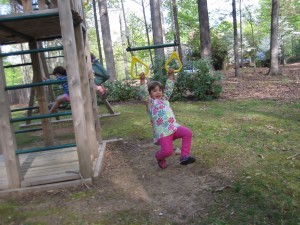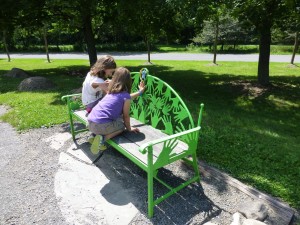Dr. Karen Pape wrote the following post on her site in August 2013. Sadly, Dr. Pape died on June 2, 2018. As a tribute to her, I’m reposting it here. Below her post, I share a comment about falling that I wrote in response to her original post. Shortly after Dr. Pape wrote this, I shared my Reflections on Outliers Post by Dr. Karen Pape which in many ways was the seed for the career transformation that I have undertaken this year.
In a previous post, I asked people to write me about Outliers…children who were doing more than expected after an early brain or nerve injury. This is Mia, demonstrating a new skill on her 4th birthday.
When you watch her “Skinning the Cat”, it is hard to believe that she had a stroke in the early days of life. The damage was to the left side of her brain, causing a right hemiplegia. Yet holding on to the rings, both hands and arms are working equally hard. Both legs swing up and over. There is no evidence of the hemiplegia. This result is not magic – it is the result of a determined child who has adopted the “I can do it” philosophy taught to her by an equally determined mother. I think both of them qualify as Outliers!
This is the link to the full story of how Mia first learned to swing, then to lift her legs up and finally over the top. http://marazoemia.net/2013/07/11/case-study-skin-the-cat/
Her mother’s description, still shots and videos, take you step-by-step through Mia’s learning process. First and foremost, Mia expects to be able to accomplish this task and she works hard, through many failures, until she reaches her goal. She is encouraged by her mother and also has the added role model of her older sister. If Zoe can do it, then I can do it! I am quite sure that during the learning process, Mia has taken some falls. She probably had a few bruises as well. Learning a new skill is a series of failures, trying new methodologies and finally success. Mia has the advantage of watching her older sister work through the same sequence of learning and she is up to the challenge.
How many children with an early brain or nerve problem are allowed to fall? When I was in clinical practice, I always checked young children for bruises on the legs. It is a normal finding in growing, exploring children. The absence of bruises often means there is an excess of watchful helpfulness. The cognitive neuroscience experts…and master coaches…understand the simple reality that learning is an experiential process. No able-bodied child has ever learned to walk without a lot of falls. Brain neuroplasticity is activated by a novel challenge. In the absence of challenge, the child’s normal habits dominate. In the past, many therapists had tried to get Mia to extend her arm and grasp. She learned how to do it when she had to…new habits are formed by novel, challenging tasks that have consequences. Read the whole post about Mia’s learning process. Her mother and sister offer some guidance and ensure her safety, but the process of trial and error…by Mia…is the way her brain learns the task.
At the end of the video, Mia says, “I flipped”. Her pride in herself is a precious gift and I am grateful to Mia’s Mom for sharing her story. We need more of them.
It’s such an honor to have Mia featured here along with Zoe and me. Thank you.
And, you guessed right, she definitely has fallen over and over. She falls all the time and happily proclaims before I can say anything, “I’m okay Mommy!” Then, she hops up and continues doing whatever has captured her attention. And manipulating band-aids for all those little boo-boos is excellent fine-motor practice for both hands, fundamentally a bimanual task.
Just yesterday, we were at a play structure and Mia was playing on a triple trapeze swing, similar to the one in the video above. Just six weeks after first doing skin-the-cat, she continues to take new risks. She can hook her legs with knees bent over the bar and hang head down. She was so bold as to let go with her hands and hang there for a few seconds seeking a thrill. And then, just as I was starting to panic wondering if she’d be able to find her grasp again on the rings she did and she flipped off the bar and had the biggest smile.
It takes some training as the parent to stand by and witness this kind of courage and determination, but the rewards are tremendous and often surprising.


